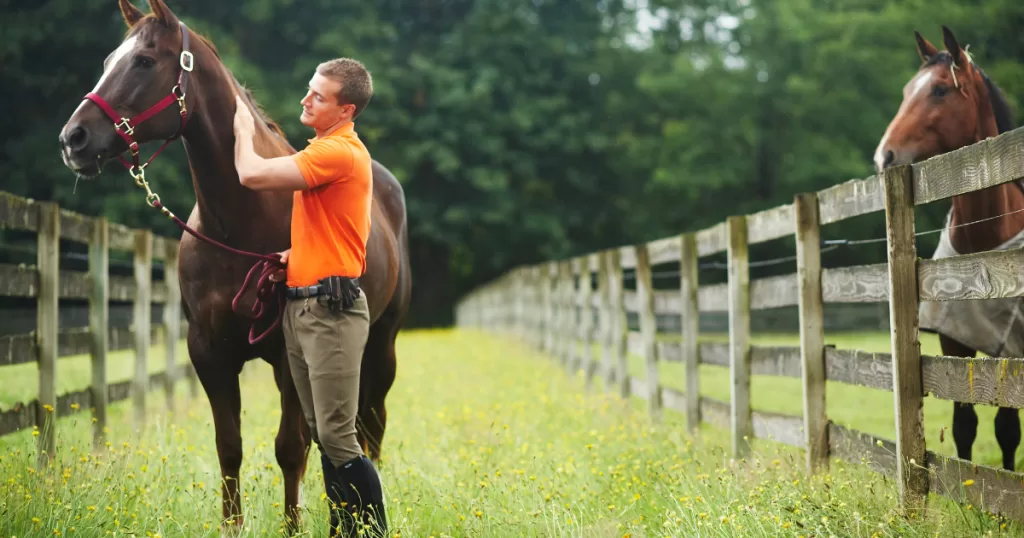
When you first start riding, learning how to communicate effectively with your horse is one of the most important skills you’ll develop. Horses are incredibly intuitive animals, but they rely on clear, consistent signals from their riders to understand what is being asked of them. These signals are known as riding commands or aids, and they are the foundation of all horse riding disciplines. Whether you’re trotting through a scenic trail or preparing for your first dressage lesson, mastering these basic commands is essential.
Ready to Become a Confident Rider?
Sign up to our Free Newsletter for exclusive tips, tricks and tidbits that will help you grow as a beginner equestrian.
Understanding the Aids
In horse riding, aids are the cues or signals you give your horse to instruct them on what to do. These aids can be divided into four main categories:
- Natural Aids: These include your hands, legs, seat, and voice. They are called “natural” because they come directly from your body.
- Artificial Aids: These include tools like whips, spurs, and reins. They are used to reinforce natural aids but should be used with care and precision.
- Weight Aids: This refers to how you position your body weight in the saddle. Shifting your weight subtly can influence your horse’s direction and pace.
- Rein Aids: The reins are an extension of your hands and are used to guide the horse’s head, which in turn controls their body movement.
Basic Riding Commands
Now that you know about the aids, let’s dive into some of the most fundamental riding commands that every beginner should know.
1. Walk On
- How to Give the Command: Lightly squeeze with your legs or gently tap your heels against the horse’s sides. You can also combine this with a verbal cue like “walk on.”
- What It Does: This command tells the horse to start moving forward at a walk. The pressure from your legs signals the horse to move forward, while your hands should remain soft on the reins to allow free movement.
2. Halt
- How to Give the Command: Gently pull back on the reins while sitting deeper in the saddle. You can also use a verbal cue like “whoa.”
- What It Does: This command asks the horse to stop moving. Your hands, seat, and legs all play a role in executing a smooth halt. Be sure to release the pressure once the horse stops, so they don’t become confused.
3. Trot
- How to Give the Command: Squeeze a little harder with your legs or give a light kick, and accompany this with a verbal cue like “trot on.”
- What It Does: This command instructs the horse to pick up speed and move into a trot, which is a two-beat gait that is faster than a walk but slower than a canter.
4. Canter
- How to Give the Command: Apply more leg pressure, specifically with your outside leg just behind the girth (the strap that holds the saddle in place), while keeping the inside leg at the girth. Use a verbal cue like “canter.”
- What It Does: This command tells the horse to move into a canter, a three-beat gait that is faster than a trot and provides a smoother ride.
5. Turn
- How to Give the Command: To turn your horse left, gently pull back on the left rein while applying pressure with your right leg. For a right turn, do the opposite.
- What It Does: This command directs your horse to change direction. The combination of rein and leg aids signals the horse to pivot their body accordingly.
6. Circle
- How to Give the Command: Apply consistent pressure with your inside leg while using your outside rein to guide the horse’s head slightly inward. Your inside rein should be relaxed but still maintain light contact.
- What It Does: This command asks the horse to move in a circular path, which is useful for improving balance and control.
7. Back Up
- How to Give the Command: Apply gentle pressure on the reins while sitting back in the saddle. Combine this with a verbal cue like “back.”
- What It Does: This command tells the horse to take steps backward. It requires a delicate touch, as too much pressure can confuse or agitate the horse.
Tips for Effective Communication
- Consistency is Key: Always use the same cues for the same commands. Inconsistency can confuse your horse and make learning difficult.
- Start with Small Steps: Don’t expect your horse to respond perfectly right away. Practice each command in a calm, controlled environment until both you and your horse are comfortable.
- Stay Relaxed: Horses are sensitive to your body language. Staying relaxed and confident will help your horse feel the same way.
- Praise and Correction: Always reward your horse with a pat or a kind word when they respond correctly. If they don’t, gently correct them and try again.
Conclusion
Learning the basic riding commands is your first step towards becoming a skilled and confident rider. These commands form the foundation of your communication with your horse, allowing you to guide, control, and connect with them in a meaningful way. As you practice and refine these skills, you’ll find that riding becomes a more enjoyable and rewarding experience for both you and your equine partner. So saddle up, practice your aids, and enjoy the journey of learning to speak the language of the horse.
Ready to Become a Confident Rider?
Sign up to our Free Newsletter for exclusive tips, tricks and tidbits that will help you grow as a beginner equestrian.
